| Published
on 21
Oct 2008 |
All rights reserved.
|
|
|

|
Stylish new Opel tries to replace
Vectra and succeeds Omega at the same time...
|
I
liked the last generation Opel Omega (1993-2003) very much. It was
handsome, spacious and great to drive. In other words, a strong rival
to BMW 5-Series of the day. Unfortunately, like most other mainstream
manufacturers, Opel lost market share to the ever rising premium brands
and eventually killed its last rear-drive executive car. The top of the
range became Vectra, which was too cheap and small to serve executive
customers, of course. As the market size of D-segment (family cars) has
been shrinking over the last decade, how to broaden the customer base
of Opel has been a key issue. To reintroduce Omega would be too costly.
How about moving the Vectra half a step upmarket and give a new name
“Insignia” ? If Opel could offer a variety of engines and equipment
levels, this car could cover the customers left by both Vectra and
Omega, and greatly enhance its sales potential. In fact, Ford has
proved this strategy successful with its larger new Mondeo.
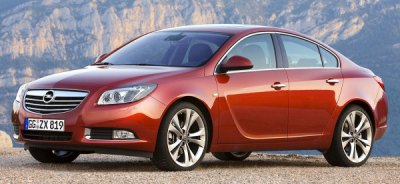
|
Classy looks is a combination of Audi
and Infiniti...
|
In the first
sight,
Insignia is a vast improvement from Vectra. Its exterior design is both
stylish and upmarket, something half Audi and half Infiniti. Its swoopy
roofline has some Jaguar XF in it, which appears to limit rear seat
head room (we shall see that later). However, Insignia does not look as
sporty as Ford Mondeo owing to a rounder and softer profile. Opel’s
design chief Mark Adams prefers a softer design theme than his
predecessor Martin Smith, who styled Astra and Corsa before moving to
Ford and designed Mondeo. It does deliver a lower drag coefficient
(0.27), and looks more elegant thanks to the use of extensive chroming
throughout its body. Inside, the dashboard design looks quite stylish
and inviting. Materials and build quality are at least as good as
Mondeo’s – perhaps slightly better –
although it can’t disgrace a new Volkswagen Golf.
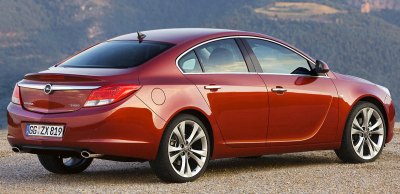
|
Swoopy roofline has negative effect to
rear passenger room...
|
What the
Insignia
isn’t so great is space efficiency. While its overall length is 50 mm
longer than Mondeo, its wheelbase is 113 mm shorter than its rival, or
in absolute term, 2737 mm. This explain why it looks large outside yet
feels small inside. When the front seats are set to accommodate
6-footers, rear passengers of the same size will find head and knee
room unusually cramped by the standard of this class. It feels at least
a class smaller than Mondeo, so how can it steal sales from the
executive car class ? The lack of space will be even more disappointing
if you know how heavy Insignia is – a base 1.6-liter model carries 68
kg more than an equivalent Mondeo, while a flagship 2.8 V6 turbo AWD
tips the scale at nearly 1700 kg ! Compare with Vectra, Insignia gains
around 140 kg, but those weight did not translate into more interior
space, sadly.
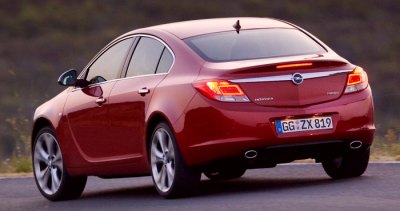 |
Optional 4WD enhances handling,
although most customers will stick with FWD...
|
The Insignia
debuts
GM’s Epsilon II platform (remark: the one underpinning Saturn Aura and
Chevrolet Malibu are Epsilon 1.5, while the old Vectra was Epsilon). As
before, the platform rides on strut suspensions up front and multi-link
suspensions at the rear, but adaptive damping has been added as option
– now even the small Astra can be equipped with this technology,
Insignia cannot omit it of course. A control system similar to Astra’s
allows the driver to select among sport, normal and comfort driving
mode, which alters suspension stiffness, steering weighting as well as
throttle response. It also links the suspensions with ESP stability
control and 4-wheel-drive system.
Talking about 4-wheel drive, this is a new option to Insignia and even
compulsory for powerful models, such as the top turbo diesel (190hp
2.0CDTI) and petrol V6 turbo engine. The 4WD system comes straight from
Saab, where it is called “XWD”. It employs a Haldex multi-plate clutch
to engage the rear wheels and, in addition, is capable of controlling
the torque split between the rear wheels.
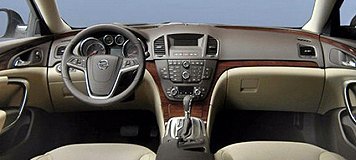 |
Interior stylish and friendly, if no
match to Volkswagen standard...
|
The Insignia
offers
a really wide range of engines, actually more than we can understand.
For such a hefty machine, why does Opel offer it a 115hp 1.6-liter
engine ? Even the 140hp 1.8-liter engine will have some difficulties to
cope with its load. The most sensible entry-level engine should be the
180hp 1.6 turbo, although it is not available yet. Right now the pick
of the range is 220hp 2.0 turbo, which offers plenty of flexibility
(thanks to 258 lb-ft of torque) and good refinement (thanks to
twin-balancer shafts). It is certainly a smarter choice than the
flagship 260hp 2.8 V6 turbo with compulsory 4WD, which is not
particular quick and could not justify its high price. Opel needs the
V6 only for image purpose.
Diesel engines are big sellers in Europe. Unfortunately, GME’s
2.0-liter CDTI engines are notorious for poor refinement. No mater in
110, 130 or 160hp guise, they produce a lot of old-fashioned vibration
in idle and sound coarse at the upper rev range. I just hope the
forthcoming 190hp twin-turbo 2.0 diesel will be more refined to match
its strong output.

|
Certainly not as driver-oriented as
Mondeo...
|
On
the road, the Insignia drives much in the same way as you would expect.
It shows plenty of grip, solidity and stability. Gearchanges are clean
and smooth. Power, in case of 2.0 turbo petrol, is abundant and
refined. The car tracks straight on highway and damp beautifully over
high speed undulations. Switch to Sport mode, the instrument readings
turn red (a gimmick) and the suspensions stiffens a little. However, it
is still not particularly sporty. Certainly not as driver-delighted as
Ford Mondeo. Despite of the use of hydraulic power steering, the
steering filters all kinds of signals from the road together with
kickbacks. It is also too light and loose to encourage driving
confidence. The chassis response is not particularly willing, more grip
than balance.
Okay, Insignia is not going to challenge Mondeo for driving excitement.
Then how about comfort and refinement ? Seems not too convincing. Ride
quality on highway is good, but on rough surfaces it is not as planted
as Mondeo. Most disappointing is that it generates a lot of road noise
on coarse surfaces. Wind noise from B-pillars is also an issue at
cruising speed. In addition to the aforementioned unrefined diesel
engines and short of interior space, Insignia has quite a lot of
problems to sort before it can match the best class standards, let
alone to be a spiritual successor to our beloved Omega. A stylish
packaging is not enough. |
Verdict:    |
Published
on 27
Jul 2009
|
All rights reserved.
|
|
Insignia OPC
|
|

|
On paper, the OPC has all ingredients
to match its target rival - Audi S4...
|
According
to its maker,
Opel
Insignia OPC - or Vauxhall Insignia VXR - is a match of Audi S4 in
performance and chassis sophistication while undercutting its rival by
10 percent. Moreover, it is available in 3 body styles - 4-door saloon,
5-door hatch or estate. Is it that good?
Look at its pretty face, you can easily believe so. Insignia has always
been a handsome car. Now with flashy air intakes and exhaust, a drop in
ride height and a set of cool alloy wheels that fill the wheel wells
fully, the OPC is immediately attractive, more so than the understated
Audi S4. Inside, the story is the same. The quality interior of
Insignia is enhanced with many alloy-looking accents, a sporty steering
wheel and delicious Recaro sport buckets. It's hard to think what can
be improved.
Read its mechanical specifications, you will find all the necessary
ingredients for a sports sedan - a highly tuned turbocharged V6, a 4WD
system with electronic controlled torque vectoring, an adaptive
suspensions / throttle mapping / power steering control with 3
selectable modes, and a reworked geometry in front suspensions to cut
torque steer. Top speed is regulated at 155 mph. 0-60 mph takes 5.6
seconds. It's not as fast as S4, but given its lower price it should
raise some eye brows at Ingolstadt, shouldn't it?
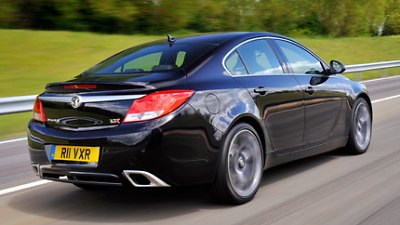
|
321 lb-ft torque arriving at 5250 rpm
explains why it feels slower than its figures suggested...
|
Unfortunately, the Insignia OPC looks better than it goes. Take the
2.8-liter turbocharged V6 for example, its fundamental is not exactly
sophisticated. Unlike Audi or BMW's counterparts, it does not have
direct gasoline injection or variable cam phasing at the exhaust
valves. It employs a single turbocharger to serve both banks of
cylinder - although that turbo has twin-scroll to separate the exhaust
flow of both banks - how can it achieve the lowest possible lag? 0.9
bar of boost pressure and a low-back pressure exhaust pretty much max
out its potential at 325 horsepower. That sounds good enough, but what
about 321 lb-ft of peak torque arriving at 5250 rpm? It explains why
the Insignia OPC feels slower than its figures suggested in real world.
It feels lazier and heavier than its rival. You need to operate its
notchy gearshift frequently to keep its engine at the high and narrow
power band.
Yes, at 1735 kg it is really a heavyweight fighter. To cope with that,
OPC has upgraded its front brakes to Brembo 355 mm cross-drilled
ventilated discs with 4-piston calipers. These "dual-cast" discs have
aluminum core to reduce unsprung mass. Accompany with the stronger
brakes are Pirelli P Zero rubbers, measuring 245/40ZR19 standard or
255/35ZR20 optional. Transmitting the engine power to the tires is the
latest Haldex 4-wheel drive system. Apart from an electromagnetic
multiplate clutch facilitating front/rear torque split, it has added an
active LSD at the rear axle. This system has been applied to Saab 9-3
Turbo X (previously known as XWD). It is capable of directing the
desired amount of torque to individual rear wheels so to alter steering
attitude.

|
HiPerStrut suspensions largely killed
torque steer, but chassis lacks interaction with driver...
|
The suspensions of OPC have been heavily modified. Its HiPerStrut front
suspensions are designed to reduce King-pin inclination hence torque
steer. This sounds similar to Ford's RevoKnuckle or Renault's
"Double-axis" suspension. Nevertheless, HiPerStrut can reduce King-pin
offset by just one-third, from 67mm to 44mm, so it is not as effective
as others. Ride height of both front and rear suspensions have been
dropped by 10mm compared with SRi (or 25mm compared with Insignia with
standard suspension). Springs are slightly stiffer. The FlexRide
adaptive damping has been recalibrated. Now it offers 3 modes -
Standard, Sport and OPC (or VXR). Frankly, Sport is actually not too
sport, as it stiffens the damping just a little. For meaningful
improvement to handling you need to engage the OPC mode. This will
switch to the stiffest suspension setting, reduce steering assistance
and speed up throttle response. Moreover, it will turn the instrument
backlight to red, reminding you that it's time for thrill.
You definitely need it, because otherwise the OPC does not engage its
driver very well. Yes, it provides bags of traction and grip. Braking
is also satisfying. The steering is accurate and well weighted. The
ride in OPC mode is firm but composed. It is a comfortable high-speed
cruiser. However, it does not feel very exciting to drive. Its exhaust
note is boring. Its handling lacks interaction with the driver. Its
steering is still devoid of information. Its 4WD system does not
respond to throttle steering. It just grip and go according to the line
in its brain, not according to your wish. In addition to the
aforementioned peaky power delivery and poor gearshift, it's hard to
persuade people to go from Audi S4 or BMW 335i to this car. Even though
it is cheaper to purchase, this advantage is largely offset by its
higher fuel consumption and emission tax.
|
Verdict:    |
Published
on 27
May 2010
|
All rights reserved.
|
|
Buick Regal
|
|
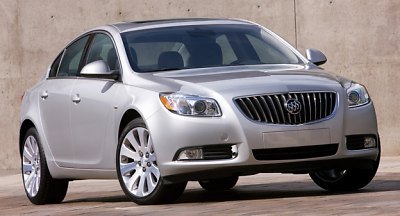
|
Insignia-based Regal is easily the
most competitive Buick for years...
|
The nameplate
Buick Regal would not have been surviving if not the strong demand from
China. While Buick is the sunset marque at its home country, it enjoys
far greater commercial success in China, where people have no idea
about its sagging fortune. GM China did very well in marketing, keeping
the last generation Regal surviving four years longer in China than in
the US. When the American design finally retired in 2008, GM China
turned to GM Europe for help. The latter generously lent its brand new
Opel Insignia, rebadged it as Buick Regal and transferred production to
China. Boosted by unprecedented style, technology and quality, the car
immediately became Buick's best seller there.
This year, Buick Regal returns to the North America market. Like the
Chinese version, it employs slightly softer suspension setting than the
European version to please American customers. But the engines they
offer are somewhat different.
Chinese car:
- 147hp
2.0 DVVT
- 170hp
2.4 DVVT
- 180hp
1.6 Turbo
- 220hp
2.0 DI Turbo
American car:
- 182hp
2.4 DI
- 220hp
2.0 DI Turbo
Moreover, the
American car has the option of adaptive damping and IDCS (Interactive
Driver Control System), both are absent on the Chinese car. In America,
Regal will sit below LaCrosse as the entry-level model of Buick. Although
it is easily the most
competitive Buick for years, it is not expected to set any sales
record. At
the moment, it will be imported directly from Germany. If GM doesn't
change its mind, expect to see its production localized in Canada from
late next year. |
Verdict:    |
| Published
on 27
Nov 2011 |
All rights reserved.
|
|
Buick Regal GS
|
|
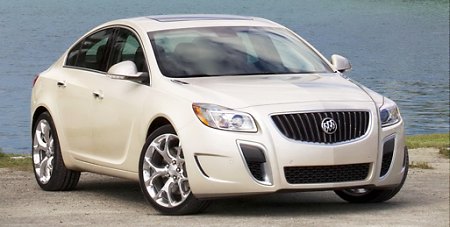
It is meaningless to say
"this is the first performance Buick since…" The current Regal has
never been a true Buick, but an Opel Insignia happened to wear an
American nameplate. For the same reason, Regal GS is not a performance
Buick, but an Opel Insignia OPC happened to arrive on the shore of
America.
Well, you may argue that the Regal GS uses a different engine. Instead
of the heavyweight 325 hp turbocharged V6, it gets a more sensible
2-liter turbo with 270 horses and 295 lbft of torque. It also lacks the
OPC's all-wheel drive system, so all power goes through the front
wheels to the tarmac. Nevertheless, the rest of the car is all OPC. For
example, its front axle is suspended on sophisticated Hiper struts to
reduce torque steer. Its suspensions get the service of CDC continuous
adaptive damping. It employs the same 6-speed manual gearbox. It runs
the same monster-size 20-inch wheels and 255/35 rubbers. Its front
brakes get the service of Brembo 4-piston calipers. Also, the
Interactive Drive Control System is carried over from the OPC. IDCS
alters suspension hardness, steering weighting and throttle response
through four modes – Normal, Tour, Sport and GS. The last mode is the
equivalent to the OPC mode on Opel. Its activation not only selects the
most extreme settings but also turns the instruments to red.
Despite of the rationalization, this car still weighs close to 1.7 ton.
It takes about 6 and a half seconds to go from rest to 60 mph, which
could be embarrassed by a Toyota Camry V6. However, the GS does
outperform the Camry in the twisty. Its handling is typical European,
with excellent body control, roadholding and braking. On the downside,
it shares the problems with OPC, namely, notchy gearshift, heavy yet
lifeless steering and a general lack of driver involvement. It fails to
translate its capability into fun, sadly.
More problematic is pricing. Starting at US$35,000 and easily topping
US$40K with options, it is no cheaper than a new BMW 328i, which is
faster, cleaner, better built and far more fun to drive. I wonder how
many people will choose it.
|
Verdict:    |
|